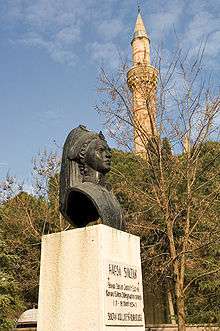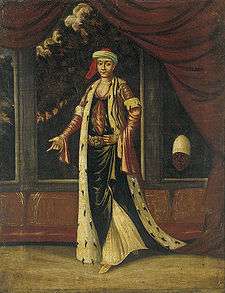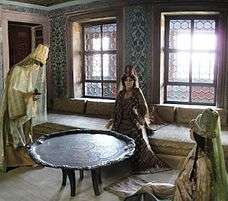Valide sultan
| Valide sultan of the Ottoman Empire | |
|---|---|
 | |
| Style | Valide Sultanefendi |
| Residence |
Topkapı Palace Dolmabahçe Palace Yıldız Palace |
| Formation | 1522 |
| First holder | Hafsa Sultan |
| Final holder | Rahime Perestu Sultan |
| Abolished | 1904 |
Valide sultan (Ottoman Turkish: والده سلطان) was the title held by the "legal mother" of a ruling Sultan of the Ottoman Empire. The title was first used in the 16th century for Hafsa Sultan, consort of Selim I and mother of Suleiman the Magnificent, superseding the previous title of mehd-i ülya ("cradle of the great").[1] Normally, this title was held by the living mother of a reigning sultan. The mothers who died before their sons' accession to the throne were never bestowed with the title of valide sultan. In special cases, there were grandmothers and stepmothers of a reigning sultan who assumed the title valide sultan.
Term
The word valide (والده) literally means "mother" in Ottoman Turkish. The Turkish pronunciation of the word valide is [vaː.liˈde].
Sultan (سلطان) is an Arabic word originally meaning "authority" or "dominion". By the beginning of the 16th century, this title, carried by both men and women of the Ottoman dynasty, was replacing other titles by which prominent members of the imperial family had been known (notably hatun for women and bey for men). Consequently, the title valide hatun (title for living mother of reigning Ottoman sultan before 16th century) also turned into valide sultan. This usage underlines the Ottoman conception of sovereign power as family prerogative.
Western tradition knows the Ottoman ruler as "sultan", but the Ottomans themselves used "padişah" (emperor) or "hünkar" to refer to their ruler. The emperor’s formal title consisted of "sultan" together with "khan" (for example, Sultan Suleiman Khan). In formal address, the sultan’s children were also entitled "sultan", with imperial princes (şehzade) carrying the title before their given name, with imperial princesses carrying it after. Example, Şehzade Sultan Mehmed and Mihrimah Sultan, son and daughter of Suleiman the Magnificent. Like imperial princesses, the living mother and main consort of reigning sultans also carried the title after their given names, for example, Hafsa Sultan, Suleiman’s mother and first valide sultan, and Hürrem Sultan, Suleiman’s chief consort and first haseki sultan. The evolving usage of this title reflected power shifts among imperial women, especially between Sultanate of Women, as the position of main consort eroded over the course of 17th century, the main consort lost the title "sultan", which replaced by "kadin", a title related to the earlier "khatun". Henceforth, the mother of the reigning sultan was the only person of non imperial blood to carry the title "sultan".[2]
Title valide carried before or after given name. According to a genealogical website, the formal way of addressing a valide is Devletlû İsmetlu (given name) Vâlide Sultân Aliyyetü'ş-Şân Hazretleri.[3] Many westerner often translated their official title, sultan, to title which not exist in Ottoman royalti officially, sultana, possibly for distinguished them from Ottoman ruler and other male member of Ottoman dynasty.

Role and position
Valide sultan was perhaps the most important position in the Ottoman Empire after the sultan himself. As the mother to the sultan, by Islamic tradition ("A mother's right is God's right"),[4] the valide sultan would have a significant influence on the affairs of the empire. She had great power in the court and her own rooms (always adjacent to her son's) and state staff.[1] Valide sultan also traditionally had access to considerable economic resources and often funded major architectural projects. In particular during the 17th century, in a period known as the "Sultanate of Women", a series of incompetent or child sultans raised the role of the valide sultan to new heights.[5]
The most powerful and well-known of all valide sultans in the history of the Ottoman Empire were Nurbanu Sultan, Safiye Sultan, Kösem Sultan and Turhan Hatice Sultan.
Most harem women who were slaves were never formally married to the sultans. Nevertheless, their children were considered fully legitimate under Islamic law if recognized by the father.[6]
List of Valide Sultans
The list does not include the complete list of mothers of the Ottoman sultans. Most who held the title of valide sultan were the biological mothers of the reigning sultans. The mothers who died before their sons' accession to throne, never assumed the title of valide sultan, like Hürrem Sultan, Hatice Muazzez Sultan, Rabia Şermi Kadınefendi, Tirimüjgan Kadınefendi, Gülcemal Kadınefendi, and Gülüstü Kadınefendi. In special cases, there were grandmothers and stepmothers of the reigning sultans who assumed the title of valide sultan, like Mahpeyker Kösem and Rahîme Piristû (Perestû).
| Name | Maiden Name | Origin | Became Valide | Ceased to be Valide | Death | Sultan(s) |
|---|---|---|---|---|---|---|
| Hafsa Sultan عائشه حفصه سلطان | Daughter of Crimean Khan Meñli I Giray.[7][8] or more likely a Christian slave[9] | 30 September 1520 son's ascension | 19 March 1534 | Suleiman the Magnificent (son) | ||
| Nurbanu Sultan نور بانو سلطان | Cecilia Venier-Baffo[10] or Rachel[11] | Venetian or Jew or Greek | 15 December 1574 son's ascension | 7 December 1583 | Murad III (son) | |
| Safiye Sultan صفیه سلطان | Albanian | 15 January 1595 son's ascension | 22 December 1603 son's death | 10 November 1618 | Mehmed III (son) | |
| Handan Sultan خندان سلطان | unknown[12] / Helena | unknown[12] / Possibly Greek | 22 December 1603 son's ascension | 26 November 1605 | Ahmed I (son) | |
| Halime Sultan[13][14] حلیمه سلطان | Abkhaz | 22 November 1617 son's ascension (first tenure) |
26 February 1618 son's deposition (first tenure) |
1623 | Mustafa I (son) | |
| 19 May 1622 son's reinstatement (second tenure) |
10 September 1623 son's deposition (second tenure) | |||||
| Mahpeyker Kösem Sultan ماه پیکر كوسم سلطان | Anastasia | Greek. Born on Tinos, Republic of Venice | 10 September 1623 son's ascension | 2 September 1651 | Murad IV (son) Ibrahim (son) Mehmed IV (grandson) | |
| Turhan Hatice Sultan
ترخان خدیجه سلطان |
Nadia | Ruthenian | 2 September 1651 mother-in-law's death | 4 August 1683 | Mehmed IV (son) | |
| Saliha Dilaşub Sultan
صالحه دل آشوب سلطان |
unknown[12] / Katarina | unknown[12] / Serb[15] | 8 November 1687 son's ascension | 4 December 1689 | Suleiman II (son) | |
| Emetullah Rabia Gülnuş Sultan
رابعه گلنوش سلطان |
Evmania Voria | Greek | 6 February 1695 son's ascension | 6 November 1715 | Mustafa II (son) Ahmed III (son) | |
| Saliha Sultan
صالحه سلطان |
unknown[12] / Alexandra[16] | unknown[12] / Greek.[17] Born in Istanbul | 20 September 1730 son's ascension | 21 September 1739 | Mahmud I (son) | |
| Şehsuvar Sultan
شهسوار سلطان |
Maria | Russian[12] / Serb[18] | 13 December 1754 son's ascension | April 1756 | Osman III (son) | |
| Emine Mihrişah Sultan[19]
امینہ مهر شاه سلطان |
30 October 1757 son's ascension | May 1762[19] | Mustafa III (son) | |||
| Mihrişah Sultan
مهر شاه سلطان |
Agnes | Daughter of Georgian Orthodox priest[20] | 7 April 1789 son's ascension | 16 October 1805 | Selim III (son) | |
| Ayşe Sîna-Parvar Sultan
عائشه سینه پرور سلطان |
Sonia | Bulgarian | 29 May 1807 step-son's ascension | 28 July 1808 step-son's deposition | 11 December 1828 | Mustafa IV (step-son)[21] |
| Nakşidil Sultan
نقش دل سلطان |
According to a myth Aimée du Buc de Rivéry[22] | According to the myth, French noble cousin of Napoleon's wife Josephine. Real origin unknown. | 28 July 1808 step-son's ascension | 22 August 1817 | Mahmud II (step-son) | |
| Bezmiâlem Sultan
بزم عالم سلطان |
Russian Jewish[23] or Georgian[24][12] | 2 July 1839 son's ascension | 2 May 1853 | Abdülmecid I (son) | ||
| Pertevniyal Sultan
پرتو نهال سلطان |
Hasna Khater | Circassian | 25 June 1861 son's ascension | 30 May 1876 son's deposition | 5 February 1883 | Abdülaziz I (son) |
| Şevkefza Sultan شوق افزا سلطان | Vilma | Georgian. Born in Russian Empire | 30 May 1876 son's ascension | 31 August 1876 son's deposition | 17 September 1889 | Murad V (son) |
| Rahime Perestu Sultan رحیمه پرستو سلطان | Rahime Gogen | Circassian | 31 August 1876 step-son's ascension | 11 December 1905 | Abdul Hamid II (step-son)[25][26] | |
Exceptional cases
Normally, living mother of reigning sultan held title Valide Sultan. But in exceptional cases, there were women who didn't hold this title when their sons became Sultan.
| Name | Maiden Name and Origin | Period[27] | Son | Note |
|---|---|---|---|---|
| Mahfiruz Hatice | Eudoxia. Serb[18] | 26 February 1618 (son's ascension) – 26 October 1620 (her death) | Osman II | Privy Purse registers no Valide Sultan during Osman's reign. Apparently, Mahfiruz fell into disfavour, was banished from the palace at some point before Osman's accession, and never recovered her status. Banishment in disgrace would explain both Mahfiruz's absence from the palace and her burial in the popular shrine of Eyüb rather than in her husband's tomb. The Venetian ambassador Contarini reported in 1612 that the sultan had had a beating administered to a woman who had irritated Kösem, perhaps this woman was Mahfiruz[2] |
| Nükhetsezâ | Georgian | 29 May 1807 (son's ascension) – 28 July 1808 (son's deposition) | Mustafa IV | Since Ayşe Seniyeperver was the first consort of the deceased Ottoman Sultan Abdul Hamid I Khan, Nükhetsezâ was not allowed to be a Valide Sultan, because she was only Hanımefendi |

See also
| Wikimedia Commons has media related to Apartments of the Queen Mother (Topkapı Palace). |
- Harem
- Seraglio
- Haseki Sultan
- Kadınefendi
- Hanımefendi
- Sultana (title)
- Ottoman Emperors family tree
- Ottoman family tree (more detailed)
- List of sultans of the Ottoman Empire
- List of mothers of the Ottoman sultans
- Queen Mother
Further reading
- Leslie P. Peirce (1993). The Imperial Harem: Women and Sovereignty in the Ottoman Empire. Oxford University Press. ISBN 978-0-19-508677-5.
- Yavuz Bahadıroğlu (2007). Resimli Osmanlı tarihi. Nesil yayınları. ISBN 978-975-269-299-2.
References
- 1 2 Davis, Fanny (1986). "The Valide". The Ottoman Lady: A Social History from 1718 to 1918. ISBN 0-313-24811-7.
- 1 2 Peirce, Leslie P. (1993). The Imperial Harem: Women and Sovereignty in the Ottoman Empire. New York: Oxford University Press, Inc. ISBN 0-19-507673-7.
- ↑ RoyalArk-Turkey at the Wayback Machine (archived April 18, 2002)
- ↑ "Muslims can celebrate Mothers Day because honoring your mother comes right after worshipping God.". Beliefnet.com. 2011-02-17. Retrieved 2015-05-15.
- ↑ Peirce, Leslie P., The Imperial Harem: Women and Sovereignty in the Ottoman Empire, Oxford University Press, 1993, ISBN 0-19-508677-5 (paperback)
- ↑ Montgomery-Massingberd, Hugh, ed. (1980). "The Imperial Family of Turkey". Burke's Royal Families of the World. Volume II: Africa & the Middle East. London: Burke's Peerage. p. 238. ISBN 978-0-85011-029-6.
- ↑ Kasaba, Reşat. A moveable empire: Ottoman nomads, migrants, and refugees. University of Washington Press. p. 44. ISBN 978-0-295-80149-0.
Hafsa Sultan, the daughter of the Crimean ruler Mengli Giray Khan.
- ↑ Peter G. Bietenholz; Thomas Brian Deutscher (2003). Contemporaries of Erasmus: A Biographical Register of the Renaissance and Reformation, Volumes 1-3. University of Toronto Press. p. 298. ISBN 978-0-802-08577-1.
Suleiman i (Solymannus), known in the West as Suleiman the Magnificent, was the son of *Selim i and Hafsa Sultan, the daughter of Mengli Giray
- ↑ Alan Fisher (1993). "The Life and Family of Suleyman I". In İnalcık, Halil; Kafadar, Cemal. Süleymân The Second [i.e. the First] and his time. Isis Press.
That she was a Tatar, a daughter of the Crimean Khan Mengli Giray, was a story apparently begun by Jovius, repeated by other western sources, and taken up by Merriman in his biography of Suleyman
- ↑ Godfrey Goodwin, The Private World of Ottoman Women, Saqi Book, ISBN 0-86356-745-2, ISBN 3-631-36808-9, 2001. page 128
- ↑ Valeria Heuberger, Geneviève Humbert, Geneviève Humbert-Knitel, Elisabeth Vyslonzil (ed.), Cultures in Colors, page 68. ISBN 3-631-36808-9, 2001
- 1 2 3 4 5 6 7 8 A. D. Alderson, The Structure of the Ottoman Dynasty, Oxford: Clarendon, 1956, p.83
- ↑ According to Yavuz Bahadıroğlu, Resimli Osmanlı Tarihi, Nesil Yayınları (Ottoman History with Illustrations, Nesil Publications), 15th Ed., 2009, page 245, ISBN 978-975-269-299-2, Mustafa I's mother is Handan Sultan.
- ↑ According to some other sources, the name of Mustafa I's mother was undetermined, but popularly known with name Halime or Alime
- ↑ İnal & Arşivi 2005, p. 27, "Siileyman'in annesi Sirp Katrin yani Dilasiip Hatun".
- ↑ İnal & Arşivi 2005, p. 27, "Mahmutun annesi Aleksandra yani Saliha Sultan".
- ↑ Meram 1977, p. 347.
- 1 2 Meram 1977, p. 355, "İkinci Mustafa'nın (Şehsuvar Sultan) takma adlı câriyesi Sırp kızı Mari'den doğan oğlu Üçüncü Osman", İnal & Arşivi 2005, p. 27, "Osman'in annesi Sirp Mari yani §ehsiivar Sultan"
- 1 2 Sakaoğlu, Necdet (2008). Bu mülkün kadın sultanları: Vâlide sultanlar, hâtunlar, hasekiler, kadınefendiler, sultanefendiler. Oğlak Yayıncılık. p. 303. ISBN 978-9-753-29623-6.
- ↑ Y. İzzettin Barış (2002). Osmanlı padişahlarının yaşamlarından kesitler, hastalıkları ve ölüm sebepleri. Bilimsel Tıp Yayınevi. p. 184. ISBN 978-975-6986-17-2.
Selim'in annesi olan Mihrişah, Gürcistan'dan kaçırılan bir papazın kızıydı
- ↑ Yavuz Bahadıroğlu, Resimli Osmanlı Tarihi, Nesil Yayınları (Ottoman History with Illustrations, Nesil Publications), 15th Ed., 2009, page 387 & 395, ISBN 978-975-269-299-2
- ↑ Christine Isom-Verhaaren, Royal French Women in the Ottoman Sultans' Harem: The Political Uses of Fabricated Accounts from the Sixteenth to the Twenty-first Century, Journal of World History, vol. 17, No. 2, 2006
- ↑ Meram 1977, p. 393, "Bezmiâlem Sultan ... Rus Yahudisin".
- ↑ Palmer, Alan, The Decline and Fall of the Ottoman Empire, p.106. Barnes & Noble Publishing, 1992. ISBN 1-56619-847-X
- ↑ Brookes, Douglass Scott, The Concubine, the Princess, and the Teacher, p.287. University of Texas Press, 2008. ISBN 0-292-71842-X
- ↑ "Sultan II. Abdülhamid Han". Republic of Turkey Ministry of Culture and Tourism. Retrieved 2009-02-06.
- ↑ The period that she had to be a Valide Sultan
Sources
- İnal, Günseli; Arşivi, Semiramis (2005). Semiramis: Sultan'ın gözünden şenlik. YKY. ISBN 978-975-08-0928-6.
- Meram, Ali Kemal (1977). Padişah anaları: resimli belgesel tarih romanı. Öz Yayınları.